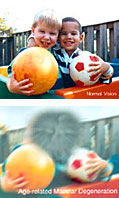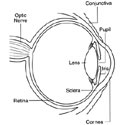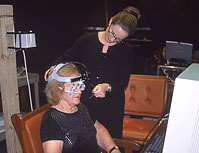An Eye on Adaptive Computing
Atlanta (February 2003) — Imagine that you've lived for 60 years with excellent vision. Slowly your sight becomes blurred. Straight lines appear wavy. Distances become difficult to judge. Gradually you notice a growing blind spot in the middle of your field of vision. Eventually, you may be left with only peripheral vision.
That's the scenario for more than 1.6 million Americans with age-related macular degeneration (AMD), the most common cause of vision impairment among people aged 60 years and older, according to the National Eye Institute (NEI), one of the National Institutes of Health (NIH).
That number is expected to increase rapidly over the next thirty years with the aging of baby boomers - the first generation to use computing devices as a part of their daily lives.
With more people than ever facing the threat of vision impairment from eye disease, engineers at Georgia Tech and physician scientists at the Bascom Palmer Eye Institute in Miami are working to understand the strategies that people with visual impairments exhibit while using computers. From this, they hope to develop computing devices to help those who suffer from visual impairments make the most of what they have left.

Improving Quality of Life
In a new study, Georgia Tech researchers are working with physician scientists and medical staff at the Bascom Palmer Eye Institute (BPEI) in Miami to develop computer-based, low vision technologies that can automatically adapt, or morph themselves, to suit the visual capabilities of individual users.
Because there is not yet a cure for AMD, the goal of the research team is to develop technologies that help improve the quality of life of people who have the disease. And while research studies are under way to learn why people develop the disease and how to better detect, treat, and prevent it, there has been little work in the area of improving their quality of life, said lead researcher Julie Jacko, a professor in Georgia Tech's School of Industrial and Systems Engineering and co-director of the Laboratory for Human-Computer Interaction and Health Care Informatics.
The Georgia Tech team, which specializes in human-computer interaction, aims to develop adaptive technologies such as desktop and portable computer applications, handheld technologies, and kiosks — devices that could be engineered to morph themselves to fit the needs of the user as the user's visual capabilities change.
The team is currently investigating the ways in which thirty seniors who have been clinically diagnosed with AMD interact with computers, compared to thirty seniors who do not have any visual impairment. The project is being funded by a National Science Foundation Presidential Early Career Award and a grant from the Intel Corporation, both awarded to Jacko of Georgia Tech, totaling $800,000 over a period of five years.

Credit: National Institutes of Health
"We're investigating the visual and motor strategies that these people exhibit when attempting to use computers so that we can design computing technologies that are engaging, easy to use, and can be incorporated into their daily lives to return the sense of independence that many of these people lose," Jacko said.
The team will be creating prototypes of such technologies including systems that would help people perform specific activities that many people with normal vision take for granted such as paying bills online, composing and sending e-mail, preparing electronic documents, even chatting online.
"The key to developing the next generation of low vision devices is in engineering products that adapt along with the changing nature of this eye disease," Jacko said. "If a person attempts to use a computer technology today, his or her ability to use that technology today may be very different from his or her ability to use that technology six months from today."

Julie Jacko
An adaptive technology possesses the intelligence to morph itself, or change specific elements or features of itself, so that it better accommodates the person using the technology. It could change itself based on a person's visual capabilities, preferences, likes, or dislikes.
"The benefit of an adaptive technology for someone who has AMD is that the technology would be able to change its appearance, or the way the interface appears on screen, to accommodate the person who is trying to use it," Jacko said.
While AMD spares peripheral vision, the disease is associated with progressive loss of central vision, making it difficult or impossible for people to read, drive, or perform other daily activities. There is no cure for the disease, but laser and pharmaceutical therapies can reduce the risk of advanced vision loss in some cases.
Low Vision Aids
Low vision aids currently on the market, such as magnifiers, large print books, telescopes, and closed-circuit television, have improved over the last decade, but still often fall short of enabling people to lead fairly normal lives, say engineers at Georgia Tech.
What's more, visual capabilities of patients with AMD often change, requiring people to constantly make adjustments in the low vision aids they use. It's the kind of frustration that compels many seniors to give up an activity altogether.
Understanding the broad range of vision-related computer capabilities of AMD patients — something that's never been studied before, Jacko says — will help as the team prepares to develop technologies for the up and coming generation of computer users reaching age 60 and beyond.
Aging Computer Users
As computer-literate baby boomers age, researchers at Georgia Tech and Bascom Palmer Eye Institute believe there will be a new interest in developing computer technologies that better suit low-vision patients.
Years ago, the idea of developing computer systems specifically for older people with vision impairments wasn't a priority. Computers weren't important to that generation. But they are to baby boomers, who came of age as computer technology exploded.
"These are people who could be highly productive, highly engaged members of our society from a technological perspective, and because of the prevalence of this disease, some people are prevented from being engaged in that way," Jacko said.
In order to develop technologies that can adapt to the abilities of each user, the team must first begin to understand the entire range of visual abilities for people with age-related macular degeneration.
Thirty Low Vision Patients Take Part In Study
AMD patients have a broad range of visual capabilities, varying from mild visual loss to visual impairment more severe than legal blindness. In some people, the disease advances so slowly that it has little effect on their vision as they age. In others, the disease progresses faster and may lead to a severe loss of vision in one or both eyes.
Using this current group of thirty seniors clinically diagnosed with AMD, along with previous studies involving more than fifty people with visual impairments, the team has begun assessing the impact of the disease by gathering "visual profiles" of the group, which includes visual acuity, contrast sensitivity, visual field, and color perception.
They want to understand the capabilities of these individuals to begin developing ideas for technology that could adapt to the user, no matter how early or advanced the condition.

Julie Jacko
Jacko and her team are testing the patients by using software they designed that captures a patient's eye movements as they attempt to work at a computer terminal. In the examination, patients are seated in front of a computer terminal and outfitted with a device that allows researchers to track eye and head movement from a bank of nearby computer monitors. In addition, the team tracks cursor movement on the screen, the time required to perform certain elements of their work onscreen, and the accuracy of their performance.
In collecting this data, researchers are able to analyze what the researchers call a person's "visual search strategies" — the manner in which they attempt to complete certain tasks on a computer, given their visual limitations.
When users successfully complete a task, like dragging and dropping a document icon into a folder, they are provided with different types of feedback in the form of highlighted images on the screen, sounds, or vibrations from the mouse. The researchers suspect that these additional cues might be beneficial in that they supplement the traditional visual feedback that is currently provided in standard applications.

Julie Jacko
They are also able to learn how people's eyes react to various graphical interfaces, and to learn where a subject's eye is drawn and what elements of computer interface pose difficulties to see or use.
This type of information is invaluable as the team prepares to work over the next twelve months to develop a prototype of a fully adaptable, multi-modal computer interface to assist patients with AMD.

Julie Jacko
In addition to the visual profiles, the team is interested in analyzing how the patients feel about their visual loss and how it affects them on an emotional level, which researchers believe impacts patients' motivation and willingness to learn about new technologies.
"If we can understand the emotional implications of this type of vision loss for these patients," Jacko said, "then we can do a better job of designing technologies that will be attractive to them and that they will be willing to use."
Throughout the past several years, the Georgia Tech team has collaborated with Ingrid U. Scott, MD, MPH, a vitreoretinal surgeon with expertise in assessing the impact of visual impairment on patients' emotional health, functional status, and quality of life. Dr. Scott and her staff at the Bascom Palmer Eye Institute (which has been rated the number one institution for eye care in the country each year for the past several years and which has the largest low vision clinic in the world) performed comprehensive clinical evaluations of each patient as well as of age-matched control subjects.
According to Dr. Scott, the risk of AMD is strongly associated with age, and it has been estimated that one in every four persons aged 64 to 74 years may develop the disease.
"Age-related macular degeneration is the leading cause of severe central vision loss in one or both eyes in people over age 50 in the United States. The disease can really impact every aspect of a person's everyday life," Scott said. "Because our aging population is learning more about the potential computer-related activities that are available to them, like e-mailing their grandchildren, Internet chatting, arranging travel plans, and obtaining information from various Web sites, it is important that technology be developed to improve access to such activities for patients with AMD. Toward this end, it is important to investigate the impact of specific visual function parameters, and the impact of graphical user interface screen features, on computer task performance in patients with AMD."

Ingrid Scott
One of the patients enlisted is a 91-year-old woman named Bess, a former concert pianist who still manages to play often on her cherished Steinway concert grand piano. It's difficult for her to read the notes from music sheets; her vision has gradually deteriorated over the last decade. She has limited vision in one eye, while in the other she is legally blind.
The team intends to construct adaptive interfaces that will be able to morph to her visual capabilities at any point in time in order to accommodate her needs. This could help Bess by enabling her to compose and play music again from sheet music that is electronically generated and displayed.
Creating an Online Diagnostic
One of the outcomes of the team's research is the development of a diagnostic tool specifically geared for low vision computer users. It would work this way: The program would instruct a computer user to perform several tasks, like using the mouse to drag a file into the trash.
Based on the user's performance, the online diagnostic tool would have the intelligence to recognize the capabilities and limitations of each user and adapt the computer's interface, such as the visual display, accordingly. This would be beneficial because of the constantly changing nature of AMD.
"This is unfortunately a disease that there is no cure for, so it's important to think in terms of quality of life," said Francois Sainfort, a professor in the School of Industrial and Systems Engineering and the William W. George Professor of Health Systems at Georgia Tech.
Sainfort, who is working with Jacko on the study, is director of the Health Systems Research Center at Tech. His research focuses on consumer and medical decision making, health care informatics, quality assessment and management in health care, and evaluation of medical technologies.
"In today's society, access to information technology is critical, whether it is at work or at home," he said. "Information appliances, such as computers, television, books, newspapers, are all media that provide information to individuals. Technologies that would enable people with some vision impairment to access information in a more effective manner would be critically important in terms of improving quality of life."

What is the Macula?
AMD primarily affects the part of the retina responsible for sharp central vision. The macula is in the center of the retina, the light-sensitive layer of tissue at the back of the eye. As you read, light is focused onto your macula. There, millions of cells change the light into nerve signals that tell the brain what you are seeing. This is called your central vision. With it, you are able to read, drive, and perform other activities that require fine, sharp, straight-ahead vision.
AMD affects patients in different ways, depending on the type and severity of the disease. It occurs in two forms: Dry AMD and wet AMD. Dry AMD affects about 90 percent of those with the disease. Its cause is unknown. Slowly, the light-sensitive cells in the macula break down. With less of the macula working, you may start to lose central vision in the affected eye as the years go by. Dry AMD often occurs in just one eye at first. You may get the disease later in the other eye. Doctors have no way of knowing if or when both eyes may be affected.
Although only 10 percent of all people with AMD have the second type, called wet AMD, it accounts for 90 percent of all severe vision loss from the disease. It occurs when new blood vessels behind the retina start to grow toward the macula. Because these new blood vessels tend to be very fragile, they will often leak blood and fluid under the macula. This causes rapid damage to the macula that can lead to the loss of central vision in a short period of time.
The Symptoms of AMD
Neither dry nor wet AMD causes any pain. The most common symptom of dry AMD is slightly blurred or distorted vision. You may need more light for reading and other tasks. Also, you may find it hard to recognize faces until you are very close to them.
As dry AMD gets worse, you may see a blurred spot in the center of your vision. This spot occurs because a group of cells in the macula has stopped working properly. Over time, the blurred spot may get bigger and darker, taking more of your central vision.
People with AMD in one eye may not notice any changes in their vision. With one eye seeing clearly, they can still drive, read, and see fine details. Some people may notice changes in their vision only if AMD affects both of their eyes.
An early symptom of wet AMD is that straight lines appear wavy. This happens because the newly formed blood vessels leak fluid under the macula. The fluid raises the macula from its normal place at the back of the eye and distorts your vision. Another sign that you may have wet AMD is rapid loss of your central vision. This is different from dry AMD, in which loss of central vision occurs slowly. As in dry AMD, you may also notice a blind spot.

For more information contact:
Megan McRainey, Communications & Marketing
Contact Megan McRaineymegan.mcrainey@comm.gatech.edu
404-894-6016



